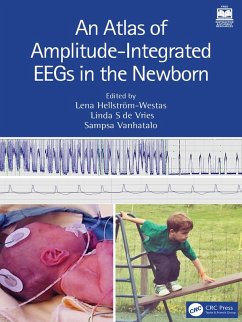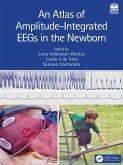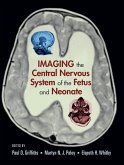An Atlas of Amplitude-Integrated EEGs in the Newborn (eBook, PDF)
Redaktion: Hellström-Westas, Lena; Vanhatalo, Sampsa; De Vries, Linda S


Alle Infos zum eBook verschenken

An Atlas of Amplitude-Integrated EEGs in the Newborn (eBook, PDF)
Redaktion: Hellström-Westas, Lena; Vanhatalo, Sampsa; De Vries, Linda S
- Format: PDF
- Merkliste
- Auf die Merkliste
- Bewerten Bewerten
- Teilen
- Produkt teilen
- Produkterinnerung
- Produkterinnerung

Hier können Sie sich einloggen

Bitte loggen Sie sich zunächst in Ihr Kundenkonto ein oder registrieren Sie sich bei bücher.de, um das eBook-Abo tolino select nutzen zu können.
This new edition updates the definitive clinical atlas textbook on interpreting continuous amplitude-integrated electroencephalography monitoring in neonatal units. It presents a comprehensive instructive overview linking tracings, scans, neuroimaging, real-time tracing clips, and detailed clinical scenarios and is an invaluable guide to all those needing to learn how to use aEEG for the best and safest results. An online quiz is available to enhance training and performance.
This third edition of the aEEG atlas summarizes the experience and evidence of more than 40 years of aEEG monitoring…mehr
- Geräte: PC
- mit Kopierschutz
- eBook Hilfe
- Größe: 94.1MB
![An Atlas of Amplitude-Integrated EEGs in the Newborn (eBook, ePUB) An Atlas of Amplitude-Integrated EEGs in the Newborn (eBook, ePUB)]() An Atlas of Amplitude-Integrated EEGs in the Newborn (eBook, ePUB)157,95 €
An Atlas of Amplitude-Integrated EEGs in the Newborn (eBook, ePUB)157,95 €![Imaging the Central Nervous System of the Fetus and Neonate (eBook, PDF) Imaging the Central Nervous System of the Fetus and Neonate (eBook, PDF)]() Imaging the Central Nervous System of the Fetus and Neonate (eBook, PDF)186,95 €
Imaging the Central Nervous System of the Fetus and Neonate (eBook, PDF)186,95 €![Midwives and Medical Men (eBook, PDF) Midwives and Medical Men (eBook, PDF)]() Jean DonnisonMidwives and Medical Men (eBook, PDF)27,95 €
Jean DonnisonMidwives and Medical Men (eBook, PDF)27,95 €![Perinatal Loss (eBook, PDF) Perinatal Loss (eBook, PDF)]() Sheila BroderickPerinatal Loss (eBook, PDF)36,95 €
Sheila BroderickPerinatal Loss (eBook, PDF)36,95 €![The Infant Motor Profile (eBook, PDF) The Infant Motor Profile (eBook, PDF)]() Mijna Hadders-AlgraThe Infant Motor Profile (eBook, PDF)28,95 €
Mijna Hadders-AlgraThe Infant Motor Profile (eBook, PDF)28,95 €![The Student Guide to the Newborn Infant Physical Examination (eBook, PDF) The Student Guide to the Newborn Infant Physical Examination (eBook, PDF)]() The Student Guide to the Newborn Infant Physical Examination (eBook, PDF)31,95 €
The Student Guide to the Newborn Infant Physical Examination (eBook, PDF)31,95 €![Examination of the Newborn (eBook, PDF) Examination of the Newborn (eBook, PDF)]() Helen BastonExamination of the Newborn (eBook, PDF)39,95 €
Helen BastonExamination of the Newborn (eBook, PDF)39,95 €-
-
-
This third edition of the aEEG atlas summarizes the experience and evidence of more than 40 years of aEEG monitoring in the newborn and also addresses the development and future of brain monitoring.
Dieser Download kann aus rechtlichen Gründen nur mit Rechnungsadresse in A, B, BG, CY, CZ, D, DK, EW, E, FIN, F, GR, HR, H, IRL, I, LT, L, LR, M, NL, PL, P, R, S, SLO, SK ausgeliefert werden.
- Produktdetails
- Verlag: Taylor & Francis eBooks
- Seitenzahl: 206
- Erscheinungstermin: 28. Februar 2025
- Englisch
- ISBN-13: 9781040297902
- Artikelnr.: 73207924
- Verlag: Taylor & Francis eBooks
- Seitenzahl: 206
- Erscheinungstermin: 28. Februar 2025
- Englisch
- ISBN-13: 9781040297902
- Artikelnr.: 73207924
- Herstellerkennzeichnung Die Herstellerinformationen sind derzeit nicht verfügbar.
signal 3. Application of electrodes, recording caveats and artefacts 4.
Seizures 5. Neonatal encephalopathy in the full-term infant due to
hypoxia-ischemia and focal brain lesion Case 5.1: Full-term infant with
mild HIE and slow recovery Case 5.2: Mild encephalopathy with evolution to
moderate encephalopathy Case 5.3: Full-term infant, mild HIE with evolution
to moderate HIE Case 5.4: Full-term infant with moderate HIE and
predominant Injury to the thalami Case 5.5: Full-term infant with moderate
HIE and predominant injury to the thalami Case 5.6: Full-term infant with
severe HIE after acute intrapartum event Case 5.7:Full-term infant with
postnatal collapse who was treated with hypothermia Case 5.8: Full-term
infant with Severe HIE Case 5.9: Term infant with severe HIE following a
sentinel event Case 5.10: Late preterm infant with moderate asphyxia and
rapid recovery Case 5.11: Hemorrhage in the thalamus in a late preterm
infant Case 5.12: Full-term infant with a temporal lobe hemorrhage Case
5.13: Full-term infant with a frontal lobe hemorrhage Case 5.14: Full-term
infant with transposition of the great arteries and a large subdural
hemorrhage Case 5.15: Full-term infant with Cortical stroke Case 5.16:
Full-term infant with posterior branch MCA Case 5.17: Full-term infant with
MCA stroke Case 5.18: Full-term infant with cerebral sinovenous thrombosis
6. Neonatal encephalopathy due to infections, metabolic disorders and
genetic causes Case 6.1: Full-term infant with hypoglycemia due to
insulinoma Case 6.2: Full-term infant with hypoglycemia Case 6.3: Full-term
neonate with Molybdenum cofactor deficiency Case 6.4: Ornithine
transcarbamylase (OTC) deficiency Case 6.5: Full-term infant with
Non-Ketotic Hyperglycinaemia Case 6.6: Pyridoxine-responsive and
pyridoxine-dependent seizures Case 6.7: Full-term infant with a peroxisomal
disorder Case 6.8: Full-term infant with acute bilirubin encephalopathy
Case 6.9: Full-term infant with Group B streptococcus meningitis Case 6.10:
Full-term infant with HSV Meningoencephalitis Case 6.11: Late preterm
infant with Rotavirus associated encephalitis Case 6.12: Full-term infant
with Incontinentia Pigmenti Case 6.13: Full-term infant with
Hemimegalencephaly Case 6.14: Hemimegalencephaly Case 6.15: Full-term
infant with cortical malformation Case 6.16: Full-term infant with
channelopathy Case 6.17: Full-term infant with Developmental and epileptic
encephalopathy (DEE) Case 6.18: Full-term infant with Intracranial tumor
(teratoma) 7. The preterm aEEG Case 7.1: Preterm infant with grade III
intraventricular hemorrhage and posthemorrhagic ventricular dilatation Case
7.2: Severe IVH/PVHI and Refractory Seizures Case 7.3: Very Preterm infant
with severe asphyxia Case 7.4: Preterm infant with severe intrapartum
asphyxia Case 7.5: Vein of Galen malformation in late preterm infant Case
7.6: Encephalitis with Bacillus cereus in a preterm infant 8. Other EEG
trends and computational measures 9. Advancing Neonatal Neurocritical Care
with Brain Monitoring Case 9.1: Term infant with congenital heart defect
Case 9.2: Preterm infant with pericardial effusion, severe metabolic
acidosis, and brain injury Case 9.3: Multimodal monitoring in a preterm
infant Case 9.4: Full-term infant with progressing mild to moderate
encephalopathy with seizures
signal 3. Application of electrodes, recording caveats and artefacts 4.
Seizures 5. Neonatal encephalopathy in the full-term infant due to
hypoxia-ischemia and focal brain lesion Case 5.1: Full-term infant with
mild HIE and slow recovery Case 5.2: Mild encephalopathy with evolution to
moderate encephalopathy Case 5.3: Full-term infant, mild HIE with evolution
to moderate HIE Case 5.4: Full-term infant with moderate HIE and
predominant Injury to the thalami Case 5.5: Full-term infant with moderate
HIE and predominant injury to the thalami Case 5.6: Full-term infant with
severe HIE after acute intrapartum event Case 5.7:Full-term infant with
postnatal collapse who was treated with hypothermia Case 5.8: Full-term
infant with Severe HIE Case 5.9: Term infant with severe HIE following a
sentinel event Case 5.10: Late preterm infant with moderate asphyxia and
rapid recovery Case 5.11: Hemorrhage in the thalamus in a late preterm
infant Case 5.12: Full-term infant with a temporal lobe hemorrhage Case
5.13: Full-term infant with a frontal lobe hemorrhage Case 5.14: Full-term
infant with transposition of the great arteries and a large subdural
hemorrhage Case 5.15: Full-term infant with Cortical stroke Case 5.16:
Full-term infant with posterior branch MCA Case 5.17: Full-term infant with
MCA stroke Case 5.18: Full-term infant with cerebral sinovenous thrombosis
6. Neonatal encephalopathy due to infections, metabolic disorders and
genetic causes Case 6.1: Full-term infant with hypoglycemia due to
insulinoma Case 6.2: Full-term infant with hypoglycemia Case 6.3: Full-term
neonate with Molybdenum cofactor deficiency Case 6.4: Ornithine
transcarbamylase (OTC) deficiency Case 6.5: Full-term infant with
Non-Ketotic Hyperglycinaemia Case 6.6: Pyridoxine-responsive and
pyridoxine-dependent seizures Case 6.7: Full-term infant with a peroxisomal
disorder Case 6.8: Full-term infant with acute bilirubin encephalopathy
Case 6.9: Full-term infant with Group B streptococcus meningitis Case 6.10:
Full-term infant with HSV Meningoencephalitis Case 6.11: Late preterm
infant with Rotavirus associated encephalitis Case 6.12: Full-term infant
with Incontinentia Pigmenti Case 6.13: Full-term infant with
Hemimegalencephaly Case 6.14: Hemimegalencephaly Case 6.15: Full-term
infant with cortical malformation Case 6.16: Full-term infant with
channelopathy Case 6.17: Full-term infant with Developmental and epileptic
encephalopathy (DEE) Case 6.18: Full-term infant with Intracranial tumor
(teratoma) 7. The preterm aEEG Case 7.1: Preterm infant with grade III
intraventricular hemorrhage and posthemorrhagic ventricular dilatation Case
7.2: Severe IVH/PVHI and Refractory Seizures Case 7.3: Very Preterm infant
with severe asphyxia Case 7.4: Preterm infant with severe intrapartum
asphyxia Case 7.5: Vein of Galen malformation in late preterm infant Case
7.6: Encephalitis with Bacillus cereus in a preterm infant 8. Other EEG
trends and computational measures 9. Advancing Neonatal Neurocritical Care
with Brain Monitoring Case 9.1: Term infant with congenital heart defect
Case 9.2: Preterm infant with pericardial effusion, severe metabolic
acidosis, and brain injury Case 9.3: Multimodal monitoring in a preterm
infant Case 9.4: Full-term infant with progressing mild to moderate
encephalopathy with seizures







